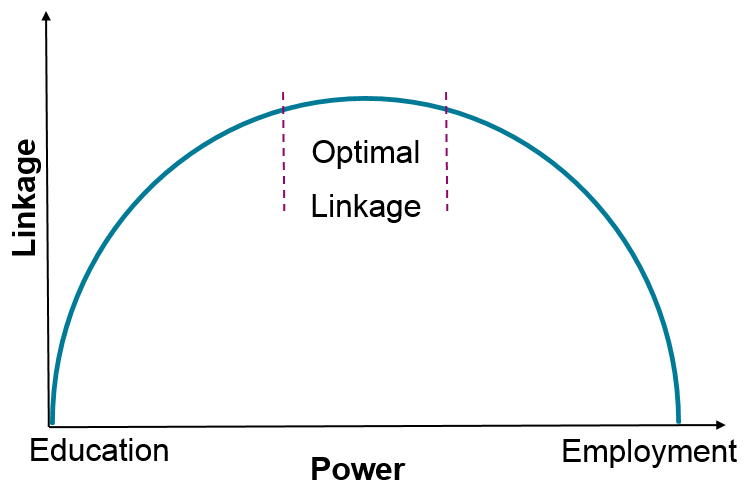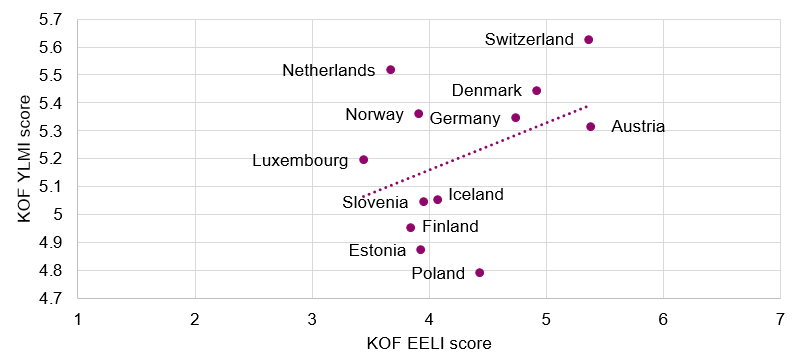KOF EELI
Welcome to the CEMETS blog! We’ll start off by explaining some of the key studies and tools we use. The first three entries will cover the KOF education-employment linkage index (KOF EELI), starting by defining education-employment linkage here, then exploring the international results in the next post and finally the specific results for an in-depth study in the American state of Colorado in the third.
By Katie Caves
You can find full information on the development of the KOF EELI here. We developed the KOF EELI in 2016 with funding from the external pageCenter on International Education Benchmarkingcall_made to measure education-employment linkage in vocational education and training (VET) programs.
Education-employment linkage is cooperation between actors from the systems for education and employment. Education-system actors are teachers, schools, and local education authorities, but also the government bodies that finance, plan, and administer education programs. Employment-system actors are workers, firms, associations of companies within specific sectors or regions, and the government bodies that manage labor and workforce development.
At its most basic, education-employment linkage is about power-sharing. The relationship is shaped like an inverted letter U, shown in the figure below. Linkage is highest when power to design, implement, and update the VET program is balanced between the two sides. It is low whenever either side has too much power.
Figure 1: Optimal linkage is about power balance
Why does education-employment linkage matter? In short, VET programs with higher education-employment linkage should be better for graduates, companies, and their local economies. For example, our initial KOF EELI study in 18 countries shows that countries with higher linkage scores tend to have higher KOF Youth Labor Market Index (KOF YLMI) scores.
When linkage is higher, young people do better on the labor market: they have jobs, transition smoothly from school to work, have better working conditions, and get education that better matches their workplace needs. The relationship shown in Figure 2 is a correlation only—we can’t control for anything with such a small sample—but it might even be underestimating the effect since the original KOF EELI study measures one VET program, not the whole system.
Figure 2: Countries with higher linkage tend to have better youth labor markets
So how do high-linkage systems help graduates, companies, and economies? Mostly by coordinating resources and balancing incentives.
Coordinating resources: High-linkage VET programs resolve information and resource differences between education- and employment actors. Educators know about pedagogy, students’ abilities, and curriculum development—among other things. Employers know about cutting-edge industry standards, the demand for various occupations, and what skills are needed to excel at work—among other things.
Education systems have resources like schools, teachers, and government funding. Employers have resources like real workplaces, expertly skilled workers, and the ability to pay wages. Both sides would have a lot of trouble getting the information and resources the other side has, so sharing is efficient.
Balancing incentives: High-linkage VET programs help balance everyone’s wants and needs. Education systems are in the business of providing general skills: knowledge and abilities that will help graduates no matter what they do later in life. This makes sense because they’re paid for by the government and education is given to every citizen.
Employers, on the other hand, want specific skills: knowledge and abilities that will help workers be more productive in a single job, occupation, or company. It’s a waste of time for companies to teach workers skills they won’t use, so they should be all about specialization.
As workers, you and I want a little of both: we want the general skills that give us mobility and options, but we want the specific skills to excel at our current jobs or get that promotion. Since education actors and employment actors have to share power in a high-linkage system, workers are most likely to get the balance we need. At the same time, each side gets enough of what it wants to make things worthwhile for them.
The KOF EELI: Education-employment linkage is tricky to measure, especially when you want to be neutral across countries, cultures, and institutional frameworks. The KOF EELI is a way of doing that, and that’s exciting because we can finally test whether linkage is as important as we think it should be. You can read all about the specifics of the index in our report, and the next post will talk about what the countries with the highest and lowest KOF EELI scores can tell us.


